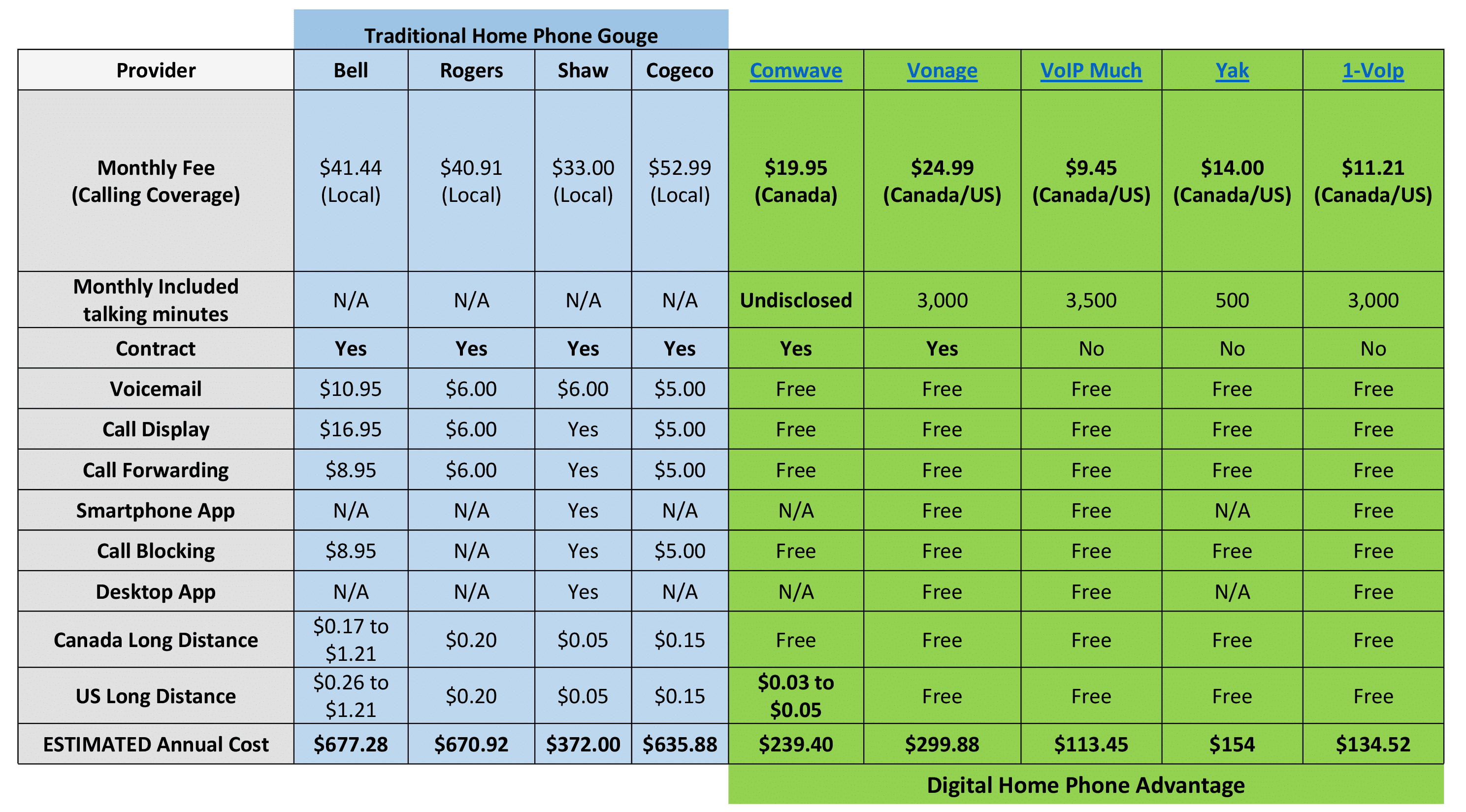Welcome to our 2017 edition of the home telephone service comparison between traditional landline and VoIP (Voice Over Internet Protocol) phone service providers.
For those who are not familiar with VoIP phone service, in a nutshell, it is a regular telephone service carried out by a VoIP Phone provider via a broadband Internet connection. Although VoIP phone service has been around for years, it is still a growing sector. Meanwhile, traditional landline service is now over 140 years old. Regrettably, landline service hasn’t seen many major advances since its inception. That is in stark contrast to the VoIP phone technology which is full of potential for both business and home use.
In this year’s home phone comparison, we will examine the monthly fees, calling features, long-distance rates, and 9-1-1 service between landline and VoIP Phone providers. Let the battles begin!
Monthly Fees
In 2017, we witnessed price increases implemented by all landline providers and a couple of VoIP Phone providers from last year. The exact reason for the increases is unclear. However, one possible reason for traditional landline providers to raise their fees may be due to their service delivery method: wires connected to each household. The wiring demands physical labor to maintain this may lead to a higher cost of the operation. As most of us can relate to, it is not uncommon for large telecommunication companies to raise their prices occasionally for their TV, Internet, and home phone services because these services are wired directly to our homes.
On the other hand, despite higher fees by a couple of VoIP providers, VoIP monthly fees, in general, are still lower than a landline provider. The reason? VoIP Phone providers rely mainly on the Internet connection to deliver their phone service. This means VoIP providers can afford to charge less than landline providers because there is no need to invest or maintain messy wires. In fact, according to our comparison chart, all the VoIP providers listed include free Canada/US long-distance calling so the actual price difference between VoIP and landline providers is even greater.
Calling Features
As discussed above, a landline provider’s physical wiring is costly to maintain. Furthermore, its analog connection limits a landline provider’s ability to introduce additional calling features inexpensively. In contrast, all VoIP Phone providers have an inherent technological advantage of working with digital signals. Therefore, it requires less effort for a VoIP provider to roll out free and more advanced calling features. In other words, lower monthly fees and free calling features are the by-products of the VoIP technology.
In this round of comparison, VoIP providers are the clear winners. The bottom line is, if you care about getting useful calling features for your home phone without spending too much money, a VoIP provider is definitely worth considering.
Please note the landline providers do offer their own calling feature packs, but for an extra fee. Also, our estimated annual costs for each landline provider are already based on including comparable feature packs so the chart reflects a more fair comparison.
Canada/US Long Distance Rates
In the round of the long-distance rates battle, a VoIP provider can deliver some damaging blows to a traditional landline provider. This is especially evident if you make frequent calls within North America. Most VoIP Phone providers offer plans with unlimited free calling within Canada and to the US. The fact that some unlimited Canada/US VoIP plans cost “less” than a landline provider’s basic plan indicates landline service fees are truly overpriced when compared to VoIP service.
To be fair, all traditional landline providers in this comparison do offer unlimited long-distance packs for North America. However, the additional fees for these calling packs widen the price gap between a landline provider and a VoIP provider.
9-1-1 Service
A home telephone is not only a communication tool but it is also depended upon during emergencies. Therefore, it is important to know that all telephone service providers (including all VoIP providers) must provide either Basic or Enhanced 9-1-1 service as mandated by the CRTC.
Finally, traditional landline providers have an edge over VoIP Phone providers because their phone service still works without power thus more reliable. In addition, its phone service will not be affected by any Internet outage or equipment failures (e.g. cable modem, phone adapter, etc.)
For your safety, you should be aware of the following about home phone services delivered by either a landline provider or VoIP Phone provider:
- Most people think traditional landline telephone service still works during power outages. This is definitely true, but for analog handsets only (unfortunately, digital handsets will not work during a power outage because the base station cannot function without power).
- VoIP phone service requires a telephone adapter and Internet connection to function. In the event of a power or Internet outage, VoIP phone service will not be available. Some good tips are; use power backup (this could run for hours) and keep a charged mobile phone around the house as a backup. You can dial 9-1-1 even if you don’t have a plan or a SIM card on the mobile phone.
Decision
So the battle of the traditional landline and VoIP phone service continues.
VoIP home phone service providers are becoming formidable challengers using its low monthly fees, free calling features, free long-distance calling, and no contracts to their advantage. On the other hand, it appears traditional landline providers are mostly defending their market shares by encouraging existing customers to bundle their services. Otherwise, they do not have many answers to the values offered by VoIP providers.
By our count, VoIP Phone providers win the match in this year’s home phone comparison because they score higher in all but one compared categories.

